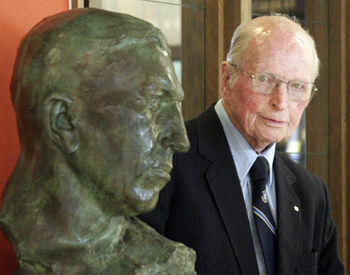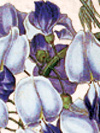| History of the Memorial Room Collection Page 7 |
|
|||||||||||||||||
 |
Expanded remarks by Professor Emeritus, Wm. C. Gibson, D.Phil.(Oxon) M.D., F.R.C.P., September 7, 1988 at the dedication of the Historical Collection of the Woodward Library, University of British Columbia. The Life Sciences Libraries thanks Dr. William Gibson for his kind permission to reproduce his historical comments on the Historical Collection of the Woodward Library. |
||||||||||||||||
|
The genuine Harvey portrait had been found by Sir Geoffrey Keynes at the abandoned and rainsoaked seat of the family, Rolls Park in Essex, built by Harvey's brother Eliab. Sir Geoffrey Keynes was preparing his Vicary Lecture for the Royal College of Surgeons and dimly remembered seeing a photograph in Country Life of the Rolls Park drawing room, showing the portrait of Thomas Harvey surrounded by portraits of his seven sons. On getting the permission of the Harvey descendants Sir Geoffrey, equipped with a ladder and a candle, entered the derelict mansion and found to his delight that the portrait with "Doctor William Harvey" painted on his chest was intact, high on the wall, though in need of cleaning. All the portraits not stolen by vandals were transferred to the Royal College of Physicians in London, where they were displayed for all to see. Suddenly that of "little William" was gone, away across the sea to Beverly Hills. Jake Zeitlin reported in 1976, in his gravel voice that the cardiologist, who kept Harvey in a closet, had been declared mentally incompetent, and his collections would have to be sold to meet large hospital care bills. Zeitlin had been engaged by the family to sell off the fine Osler collection and the Harvey portrait. The price of the painting was $100,000 U.S. I told Jake the price would have to come down to $75,000 or we would not discuss the matter. He achieved that readily. On the next weekend, when I was chopping wood at Bowen Island, I suddenly thought of letting Zeitlin into the conspiracy and phoned him to ask that he throw in his commission for a good cause. He roared with laughter as he said he certainly would. Jake was never surprised at my requests. Thus armed I telephoned to Dr. John Hayes at the National Portrait Gallery, across the street from St. Martin-in-the-Fields. He could not believe the reduction in price which had been achieved, and undertook, to speak immediately to the energetic chairman of his trustees, Lord Kenyon. John phoned back to say his lordship would guarantee $20,000. That left $50,000 to be found. After a consultation with Bruce Samis, who was always expecting a raid, I phoned back that the Woodward Library would go for $40,000 if Lord Kenyon would put in another $10,000. That was done--all in less than ten days. So we had a "farewell party" for little William at Dr. Jack Pincus' house in Los Angeles. The locals had never been able to see the portrait before. Dr. Elmer Belt, the Leonardo expert, aged 90 attended the send-off. Harvey went back to London in style. After being cleaned, and with a new oval frame he was ready for Sir Geoffrey's ninetieth birthday. Jake and Josephine Zeitlin came to the gallery, as did Sir Miles Clifford, Dr. John Hayes, Dr. Michael Perrin along with Lord Cottesloe, Lord Kenyon and their fellow trustees. Harvey can be borrowed for meetings in Vancouver and has been out to see us once already. Putting the historical collection together with so many helping hands has been a pleasure, with ups and downs no doubt. The pleasure was partly in the pursuit of these gems, and partly in the human contacts involved. I echo Mr. Woodward's feelings that we must have a living collection accessible to those genuinely interested in the milestones of science. The collection has already brought scholars from distant lands to work with these truly rare books. It would be difficult, if not impossible, to put these holdings together today. When President Wesbrook paid 21 pounds sterling for Robert Hooke's Micrographia (1665) he little knew that by 1988 the price would rise to 3,000 pounds sterling on the open market. The increase in the number of avid collectors has been one factor. The other has been the tying down permanently in institutional collections of the few volumes which a century ago were bought and sold on the open market. The foresight and trust of the founders and members of the Woodward Foundation, and of Dr. H.R. MacMillan, over the years have made this all possible. I hope that university donors such as these in the health and life sciences, and Walter Koerner and David Lam in other fields will inspire still more patrons of learning to invest in libraries. Wm Gibson, M.D., September 7, 1988 |
|||||||||||||||
|

 The wildest conspiratorial chapter began, as usual, with a telephone call from Jake Zeitlin in Los Angeles. Probably the only lifetime portrait of William Harvey, by an unknown painter had, since 1960, been in the possession of a Beverly Hills cardiologist. He had paid the heirs of the Harvey family $6,000 for it in London. Two artful dealers exported it illegally. When this fact became known to Lord Cottesloe, chairman of the overseeing group charged with preventing the export of national treasures, the dealers were heavily fined by the British Courts. It happened that his lordship owned a "Harvey portrait", of what authenticity no one knew. As Osler says there were more fake portraits of the "circulator of the blood" than of any other man in medical history.
The wildest conspiratorial chapter began, as usual, with a telephone call from Jake Zeitlin in Los Angeles. Probably the only lifetime portrait of William Harvey, by an unknown painter had, since 1960, been in the possession of a Beverly Hills cardiologist. He had paid the heirs of the Harvey family $6,000 for it in London. Two artful dealers exported it illegally. When this fact became known to Lord Cottesloe, chairman of the overseeing group charged with preventing the export of national treasures, the dealers were heavily fined by the British Courts. It happened that his lordship owned a "Harvey portrait", of what authenticity no one knew. As Osler says there were more fake portraits of the "circulator of the blood" than of any other man in medical history. 
